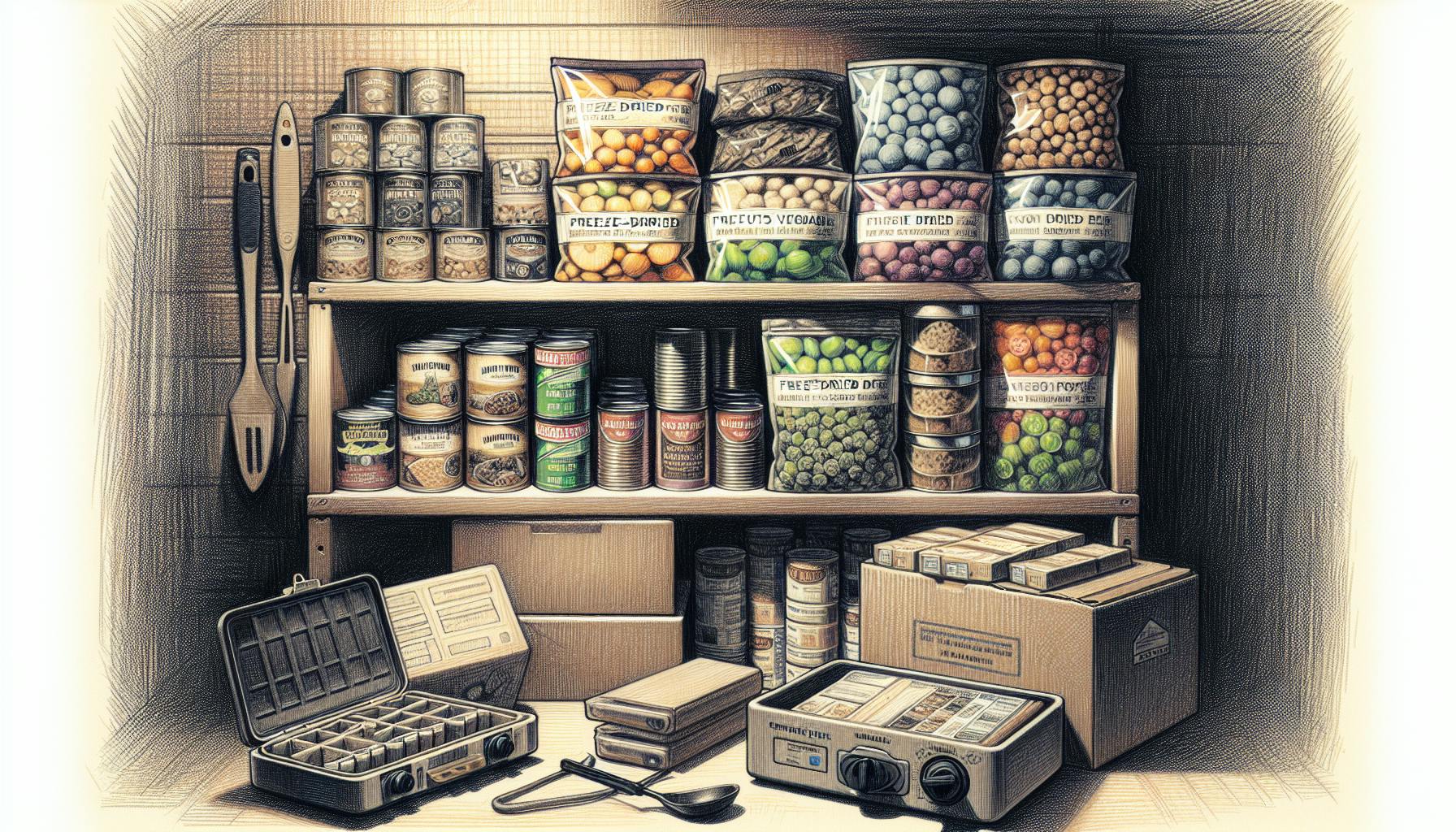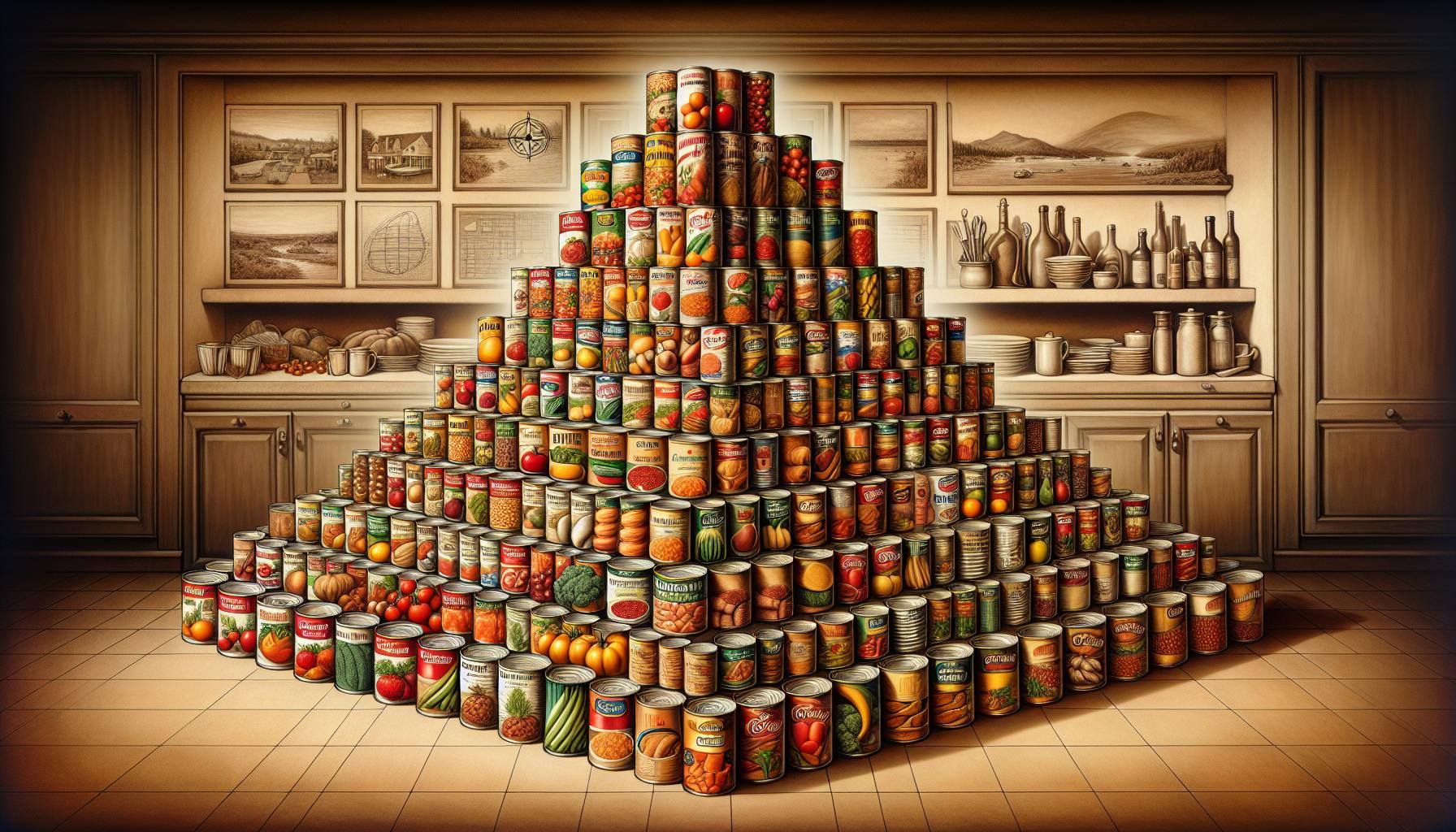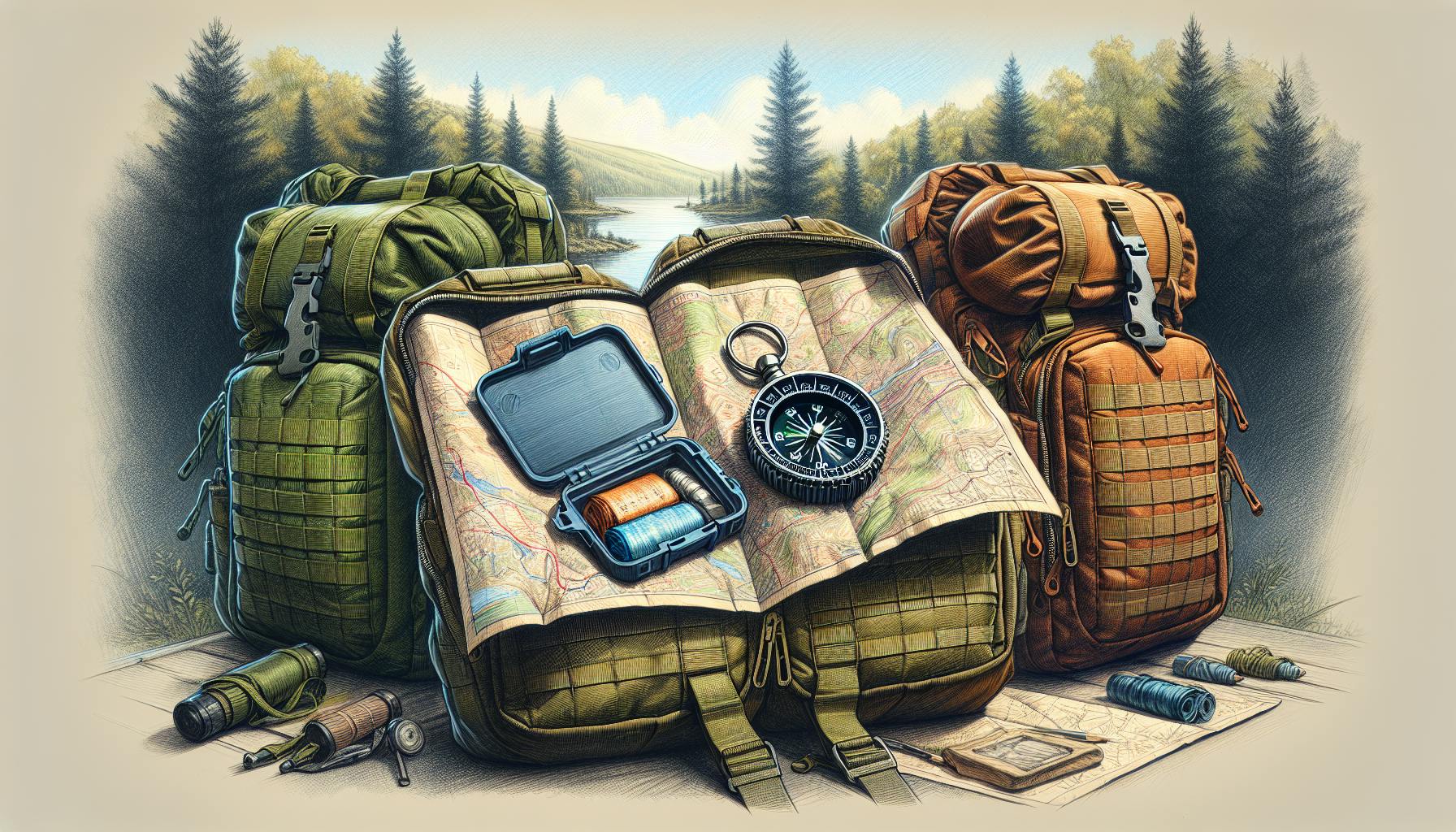When it comes to being prepared for emergencies, most would agree it's wise to have the essential supplies on hand.
This comprehensive prepper checklist outlines all the key items to stock up on so you're ready for anything from power outages to natural disasters.
You'll see the must-have survival gear including food, water, first aid, navigation tools, and more to build your preparedness supplies arsenal.
Introduction to Prepping and Survival Preparedness
Understanding the Prepper Philosophy
The "prepper" philosophy revolves around being prepared for any emergency situation or disaster by stockpiling necessary supplies and survival gear. Preppers aim to achieve self-reliance and ensure they have the resources to withstand events like natural disasters, economic collapse, civil unrest, or personal emergencies. Key aspects of prepping include:
- Gathering non-perishable food, water, medical supplies, and other critical items
- Learning key skills like first aid, self-defense, gardening, hunting, and emergency communications
- Creating evacuation plans and bug-out bags for rapid relocation if needed
- Fortifying and securing homes to withstand disasters as much as possible
Ultimately, the prepper mindset provides peace of mind and practical readiness to handle uncertain times ahead.
The Advantages of Being a Well-Prepared Prepper
The main benefits of embracing the prepper philosophy include:
- Self-reliance - Not having to depend on external systems or aid in an emergency.
- Survivability - Having the supplies and skills to survive disasters from natural catastrophes to societal collapse.
- Adaptability - Being equipped to handle a variety of situations, from power outages to civil unrest.
- Peace of mind - Removing uncertainty and anxiety by being practically ready for unpredictable events.
- Community support - Being able to help and cooperate with others during crisis situations.
Overall, prepping confers significant advantages to those who make the effort to ready themselves and their families beforehand.
Developing Your Personal Prepper Survival Plan
To develop a prepper plan, first assess potential risks and identify likely emergency scenarios based on your location, personal context, and global conditions. Then, determine the critical supplies and skills needed to endure those situations. Typical priorities include:
- Water - Stock and replenish a multi-week supply.
- Food - Store long-lasting, nutritious options.
- Shelter - Establish secure housing and bug-out locations.
- Security - Obtain means for self-defense and protection.
- Medical - Have first aid knowledge and trauma supplies.
- Power - Set up independent energy sources.
- Communication - Ensure alternate communication methods.
Continually build up supplies and skills in these areas based on budgets and storage space. Run practice drills to test plans. Adapt over time as risks and personal factors evolve.
What are the 10 essential survival kit items?
Having the right supplies in your emergency preparedness kit can make all the difference in an unexpected crisis scenario. Here is a checklist of 10 must-have items to include:
Flashlight and Extra Batteries
A flashlight allows you to navigate safely in low-light conditions. Make sure to pack extra batteries as backups. A headlamp also keeps your hands free for other tasks.
Whistle
A loud whistle can signal rescuers if you are lost or injured. Choose one with a removable compass.
Dust Mask
Dust masks filter smoke, ash, and airborne particles if evacuation is necessary. Opt for N95-rated particulate filters.
Local Maps
Familiarize yourself with local terrain using detailed topo maps. Knowing alternate routes is crucial when primary roads are blocked.
Manual Can Opener
Don't rely solely on electric can openers. A simple manual opener allows you to access canned food supplies.
Battery-Powered Radio
Tune into emergency broadcasts and weather reports using a hand cranked or battery-powered radio. Solar charging capabilities will ensure continuous use.
Games for Children
Keep kids occupied with familiar books, puzzles, and board games. Maintaining routines reduces stress and anxiety in turbulent times.
First Aid Supplies
A well-stocked first aid kit contains bandages, gauze, ointments, medications, sterile gloves, trauma shears, and other lifesaving medical essentials.
Equipping your go-bag or bug-out bag with these 10 items helps you handle numerous emergency scenarios. Prioritize prepper survival supplies that meet your family’s unique needs. Choose durable, multifunctional tools you can rely on if the grid goes down.
What should a prepper stock up on?
When building your prepper stockpile, focus on supplies that will cover your basic survival needs, including:
Food & Water
- Canned goods and non-perishables that don't require refrigeration or special preparation. Choose items lower in salt.
- Bottled water or water filtration systems to ensure access to clean drinking water.
- Seeds to grow your own fruits and vegetables.
Tools & Supplies
- Flashlights, lanterns, batteries
- Manual can opener
- Battery-powered or hand-crank radio
- Copies of important documents
- First aid kit & basic medical supplies
Additional Essentials
Depending on your family's unique needs, also consider stocking up on:
- Pet food & supplies
- Infant formula, diapers
- Prescription medications
- Contact lens solution
- Feminine hygiene products
Focus your prepper stockpile on covering basic survival necessities first. Then expand into specialized supplies for your situation. Regularly cycle through and replace expired items.
What are basic prepper supplies?
Having basic prepper supplies on hand can make a world of difference in emergency scenarios. Here is a checklist of some of the most essential items every prepper should have:
Food & Water
- Canned goods and non-perishable foods like rice, beans, pasta. Enough to last 3-7 days minimum. Consider Deluxe Siphon Pump for Gas, Diesel & Water for accessing water.
- Emergency water filtration like a LifeStraw or water purification tablets. Store at least 1 gallon per person per day.
- High energy foods like protein bars, trail mix, and dried fruits.
Tools & Gear
- Battery-powered or hand crank AM/FM radio like the Esky Emergency Radio.
- Flashlights and headlamps with extra batteries. Consider solar powered options.
- First aid kit with bandages, gauze, ointments, medications.
- Multi-tool, knife, emergency blankets and shelter, rope, duct tape.
- Backup power bank to charge devices if electricity fails.
Additional Key Prepper Supplies
- Prescription medications
- Personal hygiene items
- Cash in small denominations
- Important documents in waterproof bag
- Map of the local area
Prioritize lightweight, portable items that meet your basic needs. The exact prepper supplies carried will vary based on factors like climate, location, and potential risks. But having these basics covered is key for emergency preparedness.
What are good emergency supplies?
Having the right emergency supplies on hand can make all the difference when a disaster strikes. Here are some of the most essential items every prepper should have in their survival kit:
Water
- Store at least one gallon of water per person per day for evacuation kits, and 2 weeks' worth for home kits. Water is critical for survival, so stock up on bottled water or jugs. Consider adding a Deluxe Siphon Pump to transfer water between containers.
Food
- Pack high-calorie, non-perishable foods like granola bars, canned goods, trail mix, and freeze-dried meals. Choose items that require no refrigeration and minimal preparation.
Tools
- A sturdy multi-tool, fire starter, duct tape, work gloves, flashlight, and batteries are essentials. A battery-powered or hand crank NOAA weather radio will allow you to monitor emergency broadcasts.
First Aid Supplies
- Stock your kit with bandages, gauze, medicines, sanitation supplies, and other items to treat injuries until professional medical care is available.
By preparing well-stocked prepper supplies for evacuation and home use, you'll be ready to handle a wide range of emergency scenarios. Revisit your kits every 6 months to check expiration dates and replenish anything used up. With the right survival gear close at hand, you and your family will stay safe in the event of a disaster.
sbb-itb-b932644
Essential Prepper Survival Supplies Checklist
Being prepared for emergencies requires having the right supplies on hand. This section provides a comprehensive checklist of essential items every prepper should have in their kit.
Prepper Water Supply: Storage and Purification
- Store at least 1 gallon of water per person per day for a minimum of 3 days. Consider storing a 2 week supply if possible.
- Use food-grade plastic barrels or containers to store water long-term. Ensure containers have a tight seal.
- Water purification methods: water filtration systems like Lifestraw or Sawyer filters; water purification tablets; boiling water for 5-10 minutes.
- The Deluxe Siphon Pump enables extracting water from additional sources like streams, ponds, pools, etc. It works for gas, diesel, and water.
The Ultimate Prepper Food Supplies List
- Stock up on non-perishable foods with a long shelf life: canned goods, rice, beans, pasta, oats, trail mixes, protein bars, etc.
- Focus on nutrient-dense foods to sustain health: canned salmon, tuna, vegetables, fruits.
- Ensure adequate daily calorie intake with grains, legumes, nuts, dried fruits.
- Rotate stock every 6-12 months to keep it fresh. Use first-in, first-out system.
Comprehensive First Aid and Medical Kit
- First aid: bandages, gauze, tape, trauma shears, gloves, medications, antiseptic wipes.
- Instruments: thermometer, tweezers, safety pins, scissors.
- Medications: pain/fever relievers, anti-inflammatories, antihistamines, antibiotics, antacids.
- Specialized items like splints, suture kits, saline.
Prepper Kit List: Navigation and Communication Tech
- Battery, solar, and hand crank powered radios for weather reports, emergency broadcasts.
- Maps, compass for navigation if GPS fails.
- Emergency whistles, signal flares.
- Two-way radios for communication.
- Weather radio for storm tracking.
Outdoor Survival Gear Essentials
Survival Shelter and Sleep Systems
Having reliable shelter and insulation is critical for outdoor survival scenarios. Portable tents, tarps, and bivvy sacks made of waterproof, tear-resistant materials like silnylon provide durable overhead protection from the elements. Inflatable sleeping pads with insulation ratings of R-3 or higher block ground cold. Mummy-style sleeping bags with temperature ratings appropriate for the climate help retain body heat. Compactness and low weight are ideal features for bug out bags.
The Snugpak Stratosphere 1 Person Tent and Sea to Summit Reactor Extreme Sleeping Bag make a reliable shelter system. Pair them with a Therm-A-Rest Z Lite Sol Ultralight Foam Camping Sleeping Pad for insulation.
Fire Starting and Outdoor Cooking Gear
Reliable fire is essential for purifying water, cooking, and staying warm. Waterproof stormproof matches, ferrocerium rod fire starters, and windproof butane lighters provide redundancy. The Ultimate Survival Technologies BlastMatch Fire Starter integrates several fire starting methods.
Portable wood gasifier stoves like the Solo Stove Lite enable cooking without carrying fuel. Pair with a Stanley Adventure Camp Cook Set for versatility.
Illumination and Power Solutions
Rugged, waterproof LED flashlights like the Streamlight ProTac HL USB provide personal lighting. Integrate portable power banks like the Anker PowerCore Slim 10000 PD to charge devices. Solar panels and generators offer renewable electricity generation for extended durations. The Renogy 100W Solar Panel Suitcase folds for transportability.
Self-Defense and Security Prepper Supplies
Being prepared for emergency situations often requires having self-defense and security supplies on hand. When disasters strike, chaos can ensue and preppers may need to defend themselves, their families, and their property. This section covers key items that preppers should consider having in their survival kit.
Tactical Flashlights for Illumination and Protection
A reliable tactical flashlight is an essential item for preppers to have. High-lumen flashlights like the Anker Bolder LC90 or Fenix PD35 TAC provide powerful personal illumination and can even act as an improvised self-defense tool if needed. Key features to look for include:
- High Lumens - At least 1000+ lumens for maximum brightness. Illuminates threats from afar. Can temporarily blind attackers.
- Strike Bezel - A crenelated bezel for hammering if needed in emergency close combat.
- Waterproof & Durable - Rugged and waterproof (IPX-8 rating) for reliable operation in tough conditions.
Having a reliable tactical flashlight provides lighting, signaling, and protection capabilities. It's an essential item for any prepper's go-bag or bug out bag when planning for emergency scenarios.
Personal Defense: Pepper Spray and Alarms
In addition to tactical flashlights, preppers should strongly consider compact self-defense items that can ward off attackers and call for help if needed:
- Pepper Spray - Legal sprays like Sabre Red or Fox Labs provide a non-lethal way to incapacitate threats from a distance. Key for close quarters defense.
- Personal Alarms - Loud 120+ dB alarms like the Vigilant 130 dB can scare off attackers and signal for assistance. Crucial backup to pepper spray.
Having pepper spray and a personal alarm provides preppers legal, non-lethal self-defense options during unrest. These items take up little space so are easy to keep in a bag or on body for constant access security and protection.
Secure Communication with Two-Way Radios
When cell towers go down in disasters, two-way radios become crucial for communication. Prepper teams should equip themselves with GMRS radio sets like the Motorola T800 for coordinating logistics and security once phones are unusable. Features to look for include:
- 20+ Mile Range - Long range for communicating between base and patrols.
- NOAA Channels - Built-in NOAA channels provide weather / emergency alerts.
- Rugged and Waterproof - Durable enough for tough outdoor use during disasters.
With the potential for destroyed infrastructure and overloaded networks in disasters, having reliable two-way radios is a prudent security investment for preppers when planning emergency communications.
Comprehensive Prepper Gear for All Scenarios
This section highlights additional worthwhile prepper supplies to consider, including versatile tools, protective equipment, hygiene products, and specialized gear.
Versatile Multi-tools for Everyday Preparedness
Compact multi-tools like the Leatherman Wingman are extremely useful for preppers. Features like knives, screwdrivers, pliers, and wire cutters allow you to handle essential repairs and crafting tasks. The portability also makes multi-tools ideal for including in bug out bags and emergency kits.
Consider stocking multiple multi-tools - having backups ensures you are prepared if one gets lost or breaks. Also, specialized tools like the Leatherman Signal add functionalities like fire starters, whistles for signaling, and hammer heads that are handy for survival situations.
Protective Gear for Hazardous Environments
Protective equipment is vital for preppers to shield themselves from contaminants. Items to stockpile include:
- Gas masks - Guard against airborne biological/chemical threats. Look for military-grade models.
- Biohazard suits - Essential PPE for handling contaminated waste or quarantine scenarios.
- Radiation detectors - Identify radioactive contamination. Geiger counters are most accurate.
- Potassium iodide - Protects thyroid gland from absorbing radioactive iodine.
Be sure to learn how to properly wear protective gear items to avoid exposure. Also stock spare filters, batteries, and other replaceable components.
Hygiene and Sanitization Essentials
When infrastructure fails, maintaining cleanliness and health is difficult but critical. Stockpile:
- Bar soap, shampoo, toothbrushes
- Disinfectants like bleach to purify water
- Antibacterial wipes to clean surfaces
- Absorbent towels to conserve water
- Tampons, pads, adult diapers
Rotate stock every 6-12 months to keep products effective. Have at minimum a 90 day supply for each person.
Being prepared with hygiene and sanitization essentials prevents illness and supports overall wellness when SHTF.
Prepper Supplies Clearance: Maximizing Your Budget
Taking advantage of sales and buying in bulk can help preppers stretch their budgets. Focusing on essential items first allows you to prepare without breaking the bank.
Budget-Friendly Prepper Essentials
When looking for discounts on prepper gear, prioritize necessities over wants. Good places to save include:
- Water filtration/purification (e.g. Lifestraws or Sawyer filters)
- Long-term food supplies (rice, beans, canned goods)
- First aid kits
- Emergency radios
- Flashlights/lanterns
Shop clearance sales and buy generics where possible. Quality matters for critical items like water filters.
Bulk Buying Strategies for Prepper Food and Supplies
Buying bulk dry goods helps stock your pantry for less. To save money:
- Shop sales and club stores for bulk grains, beans, canned goods
- Split large packages with friends
- Use mylar bags and oxygen absorbers to store bulk items
- Freeze extras if you can't use it all now
When buying perishables in bulk, only purchase what you'll use or can preserve.
Quality vs. Cost: Making Smart Prepper Purchases
With key items like generators and bug out bags, don't sacrifice too much quality for cost. Cheaper alternatives may fail when you need them most.
Prioritize gear you may rely on during an emergency, like:
- Water filtration
- First aid
- Knives
- Shelter (tent, tarp)
- Navigation (map, compass)
For general tools and supplies, more affordable options should suffice. Always comparison shop and read reviews.
Final Thoughts on Building Your Prepper Survival Arsenal
As a prepper, having the right survival supplies and gear is critical for emergency preparedness. This comprehensive checklist covers all the essentials, from prepper survival supplies like food, water, and medical kits, to necessary survival gear like radios, lighting, and self-defense items.
By utilizing this list when building your reserves and supply caches, you can ensure you have all your bases covered for various emergency scenarios. Make sure to customize the checklist to your specific needs and tailor the items to the likely risks in your geographical area.
The key is to methodically and gradually build up your prepper arsenal over time. Start with the most vital supplies, then add secondary and supplemental gear as your budget allows. Take advantage of sales and clearance deals on prepper items whenever possible as well.
With the proper planning and preparation, you can achieve a state of true self-reliance and readiness. Stay vigilant in keeping up with world events, threats, and potential disruptions that could impact your area. Continually review and refine your preparedness plans and gear supply to account for new risks or developments.
By making emergency preparedness a way of life, preppers develop important survival skills, deeper connections with community, and peace of mind knowing they can weather any storm. Use this checklist as your faithful guide in building the robust and well-stocked prepper survival arsenal you need to protect yourself and your loved ones.


